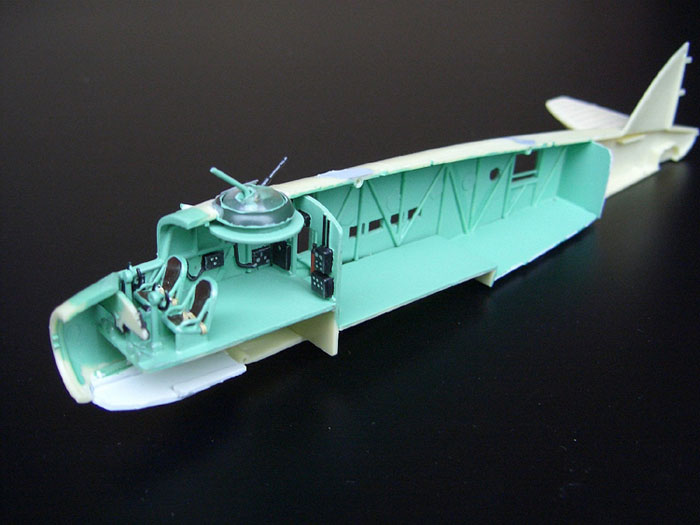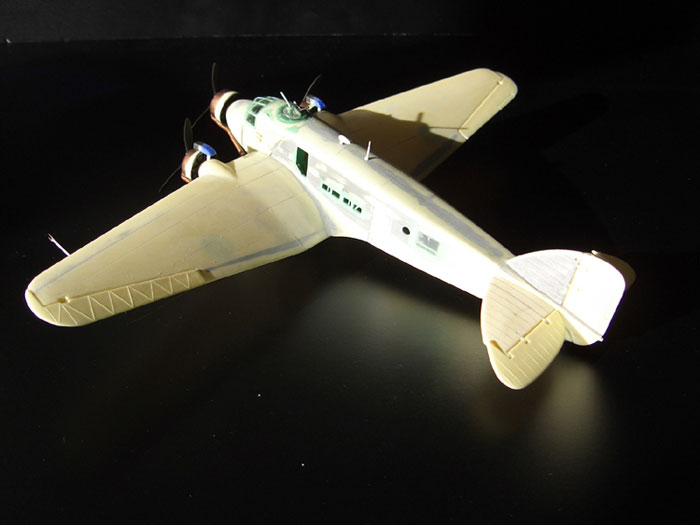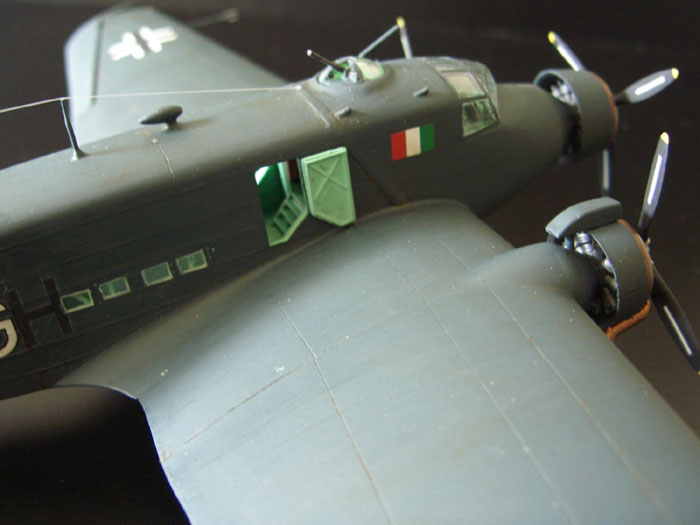|
Supermodel's
1/72 scale conversion
Savoia-Marchetti SM.81T
by
Peter Ibes
|
 |
|
Savoia-Marchetti SM.81T |

Classic
Airframes' 1/48 scale Fiat CR 42 AS is available online from
Squadron
When it comes to modelling, I love those esoteric subjects from World
War II. So when I came across photographs of a number of Savoia
Marchetti S.M. 81 Ts of the ANR and the Thierry Dekker artwork in
‘Camouflage and Markings of the Aeronautica Nazionale Repubblicana
1944-45’, I just has to build one by converting the ancient, but still
good Supermodel 1:72 kit.
Background
The Savoia Marchetti S.M. 81 Pipistrello (Bat) was the bomber version
of the S.M.73, an 18 passenger airliner dating from 1934. The aircraft
was a tri-motor with fixed undercarriage, and made of wood (wings) and
welded steel tubing with canvas covers. Introduced into service in 1935,
the Pipistrello was used by the Regia Aeronautica during the invasion of
Ethiopia, and later in support of the Nationalists forces in the Spanish
civil war. At the start of World War II the aircraft was actually
outdated, but it continued to soldier on in service, particularly in
North-Africa.
Because of its rugged reliability the remaining Pipistrellos were
converted into transport planes with the designation S.M. 81 T (T =
Trasporti) from 1942 onwards. For this purpose the bomb bay gave way to
a flat floor, the two gun turrets with double machine guns were replaced
with a single Lanciani ‘Delta’ turret with a 12.7 mm machine gun, while
the engines were exchanged for new Alfa 126 RC 34s. In addition the
spats were removed from the undercarriage, with the exception of the
lower plate with functioned as a mud guard.
After the Italian surrender in September 1943, the Luftwaffe managed to
seize a large number of S.M. 81s on the Balkans and in the axis
controlled part of Italy, although several managed to escape to the
south, to be incorporated in the Co-Belligerent air force.
In the mean time, Mussolini had been freed from his mountain top prison
at Gran Sasso, to become the leader of the Repubblica Sociale Italiana,
in the part of Italy still occupied by the Germans. This ‘new’ state
also had its own air force, the Aeronautica Nazionale Repubblicana (ANR)
that continued to fight on the Axis’ side against the Allied forces.

Apart from units equipped with fighters and torpedo bombers, the ANR
also had a single transport unit, the 1º Gruppo Aerotrasporti ‘Terracciano’.
In early 1944 this units received a number of refurbished and converted
S.M. 81s - that were captured by the Luftwaffe in 1943 - in order to
carry out supply and ferrying flights to the Eastern Front from Goslar,
Germany.
But in August 1944 the German High Command launched ‘Operation Phönix’,
an attempt to gain direct control over the ANR. Part of this plan was
that all personnel would swear an oath to the Führer and would be
brought under German command. As a vast majority of the ANR pilots and
ground crews refused to do so, they were repatriated to Italy without
their airplanes. What happened next to the remaining S.M. 81s is not
known.
Specifications Savoia Marchetti S.M. 81 T
Span: 24.00 m
Length: 17.80 m
Height: 4.45 m
Maximum Airspeed: 340 km/h
Range: 2,000 km
Armament: a single 12.7 mm machine gun in a Lanciani ‘Delta’ turret
I bought the Supermodel 1/72 kit of the S.M. 81 as a souvenir in
Italy years ago, and it has been in my stack of inbuilt kits for quite a
while. The boxing dates back to the 1970s and although the plastic is
fairly thick and it doesn’t have engraved panel lines, it can still be
built into a nice model.
In the box decals for two bomber versions are included; one from the
late 1930s in Cachi Avorio Chiaro (ivory white), with red
anti-camouflage stripes over the wings (for emergency landings in the
desert), and one from the early stages of World War II in two shades of
green (Verde Oliva Scuro and Verde Chiaro), with a light blue-grey (Grigio
Azurro Chiaro) underside.
Fuselage
I started with both fuselage sides. The bomber version originally had
a side door with a bevelled edge. For a transport plan that is rather
unpractical, so the some of the S.M. 81s had this replaced with a square
roller-shutter door (neat!). I simulated this by gluing a number of thin
plastic strips on a piece of plastic sheet, which I glued in the
squared-off door opening. Also the rear fuselage side windows were
squared-off, and covered with a piece of clear acetate sheet.
The transport version had most of the round fuselage windows
blanked-off. These were glued into the fuselage halves, with the
exception of the rear board window, covered with putty and sanded
smooth. Further the cut-outs for the lower turret and the bomb aimer
position were blanked off, using plastic sheet and putty. The new upper
turret required a small rim with a smaller diameter than the original
one. For this I used the spare cowling ring of a Hasegawa Raiden. The
final adaptation was cutting out four small square windows in each
fuselage side, as per the photographs in the ANR book.
Interior
After all the preparatory work on the fuselage halves, I now turned
to the interior. Straight from the box the interior is rather basic, but
inspired by the magnificent S.M.81 model of Scott Battistoni on
www.hyperscale.com, I took to work. Using plastic sheet, rod and tube I
created a lengthened flat floor, ribbing, radios, various bits and
pieces and a new centre console, while also further detailing the kits
seats.

The interior was painted light grey-green (Verde Anticorrosione), for
which I used my own mix of Humbrol 23 and 101, with the details
highlighted in black, silver and white. The seat belts came from the
metal etch set of the Aviation Usk S.M. 84. After allowing the paint to
dry, the fuselage halves were joined, trapping the (slightly converted)
new turret, and the kit’s cockpit after polishing it for clarity.
Undercarriage
The undercarriage of the transport version of the Pipistrello had its
spats removed in order to save weight. Only the lower plate was retained
as a mud guard. Since the spats of the kit are an integral part of the
undercarriage, it took me a while to figure out how this was
constructed. In the end I created a new pair, using the kits parts, rod,
plastic sheet and the wheels from an Italeri B-25 Mitchell.
Other Details
The S.M.81 had canvas covered vertical and horizontal tails with
prominent ribbing. As this is lacking on the kits parts, I recreated
this by gluing bits of stretched sprue onto the tail surfaces, which
were faired in with a thin layer of glue. After a light sanding it looks
quite convincing.
The Lanciani turret of the S.M.81T was a lot smaller than the original
double gun one. I just happed to have sentenced a Supermodel Cant Z. 506
to the spares box and proved to be a perfect fit. After making some
small adjustments a German machine gun was added and a counterweight,
both also from the spares box.

The Alfa Romeo engines of the S.M. 81 T had sand filters mounted on top
of the cowlings. I made these from thin plastic sheet, based on photos
from the book by Ferdinando D'Amico and Gabriele Valentini. The aircraft
I was building, 8Q+GH, only had them on the outer engines, so I just had
to make two. Further I made new exhausts from bent sprue, with the end
openings slightly drilled out.
The final additions were a new pitot tube from rod and some bent wire, a
new antenna made from rod and tube and small wingtip lights from pieces
of rod. I also added three small air intakes from rod on top of the
cabin, as well as new flap hinges. The teardrop antenna also came from
the Cant Z 506. Further all panel lines were sanded off and then
rescribed.
The S.M.81Ts of the ANR flew in the standard Italian ‘continental’
scheme of Verde Oliva Scuro (dark olive green) on top and Grigio Azurro
Chiaro (light blue-grey) underneath, for which I used Humbrol 134
(unfortunately OOP) and Humbrol 64 light grey. Further, as they were
used on the Eastern Front, the machines had yellow fuselage bands and
lower wingtips (Humbrol 24). The propellers were black with silver hubs
and yellow tips.

For the exhausts I used a mix of fire bronze and black, which gives a
nice rusty metallic colour.
Decals
The black crosses and swastikas came from various Luftwaffe bomber
sheets from Superscale, the ANR flags (with the yellow trim cut off)
from Tauro sheet 72-517. The Q8+GH codes were created on an ALPS printer
by fellow IPMS member Rob van Riel.
Final Touches
With the decals applied, the whole model was coated with ModelMaster
Dullcote. Soot from the exhausts was added using a thinned mixture of
grey and black, while the panel lines were highlighted used a mixture of
brown and black water colours. And ‘presto’, a unique version of a kit
you hardly ever see built (except on Hyperscale that is). And now that
Italeri is reissuing all these fantastic Supermodel kits, maybe I should
try one of these garishly painted S.M. 81s from Spanish civil war…
- Camouflage and Markings of the Aeronautica Nazionale
Repubblicana 1944-45 - Ferdinando D'Amico & Gabriele Valentini,
Classic Publications, Hinckley, Leicestershire, England, 2005
- Colori e Schemi Mimetici della Regia Aeronautica 1935-1943,
Umberto Postiglioni & Andrea Degl’Innocenti, G.M.T-C.M.P.R-G.A.V.S,
Trento, Italy, 1995
- The Concise Guide to Axis Aircraft of World War II, David Mondey,
Chancellor Press, London, England, 1984
- Hyperscale.com (
http://hsfeatures.com/sm81sb_1.htm )
Click the thumbnails below to view larger images:
Italian Aces of World War
2
Aircraft of the Aces 34 |
|
|
|
|
Author: Giorgio Apostolo
Illustrator: Richard Caruana
US Price: $19.95
UK Price: £12.99
Publisher:
Osprey Publishing
Publish Date:
November 25, 2000
Details: 96 pages; ISBN: 1841760781 |
|
|
Model, Images and Text Copyright © 2006
by Peter Ibes
Page Created 24 April, 2006
Last Updated
21 February, 2007
Back to
HyperScale Main Page
|
Home
| What's New |
Features |
Gallery |
Reviews |
Reference |
Forum |
Search